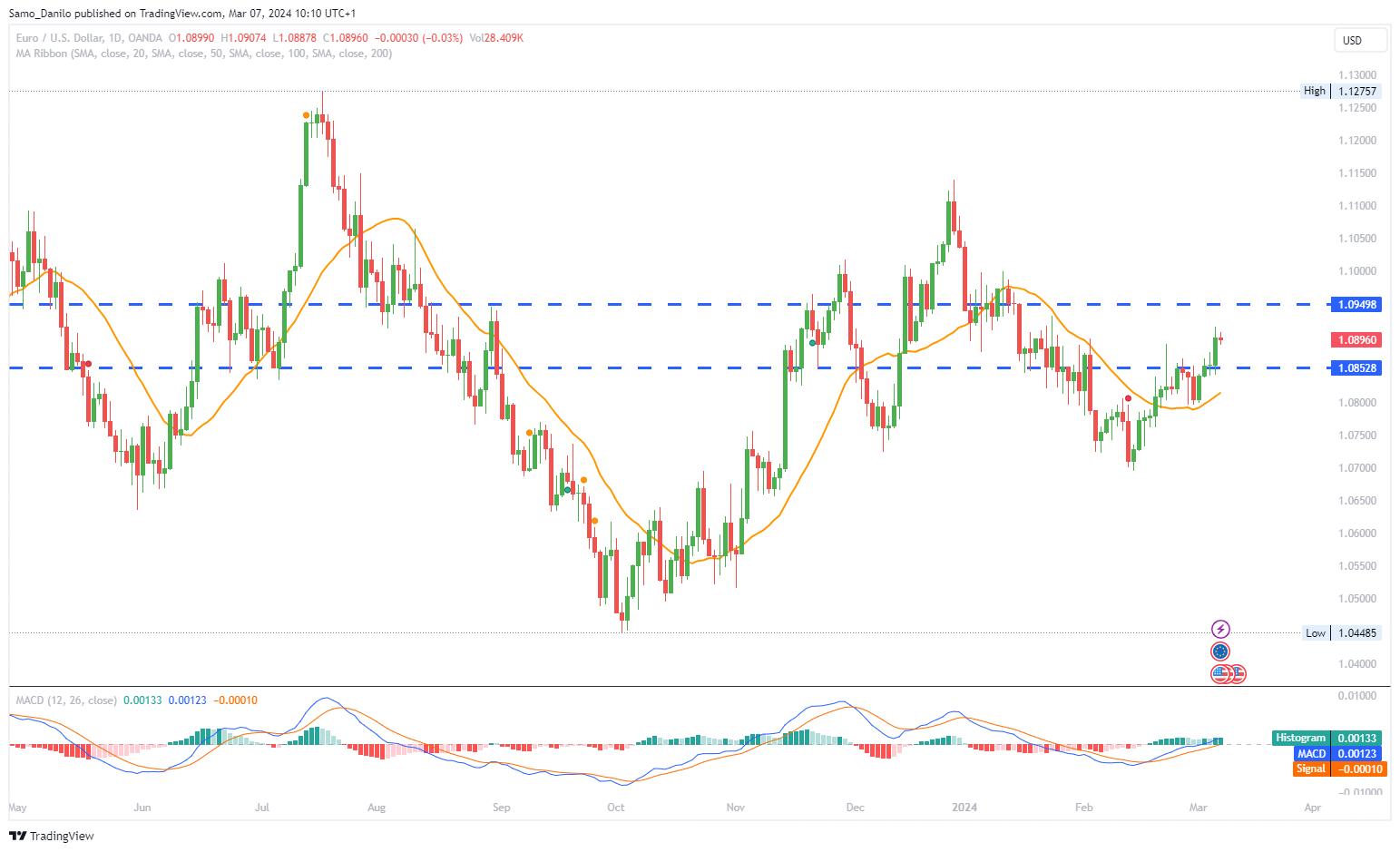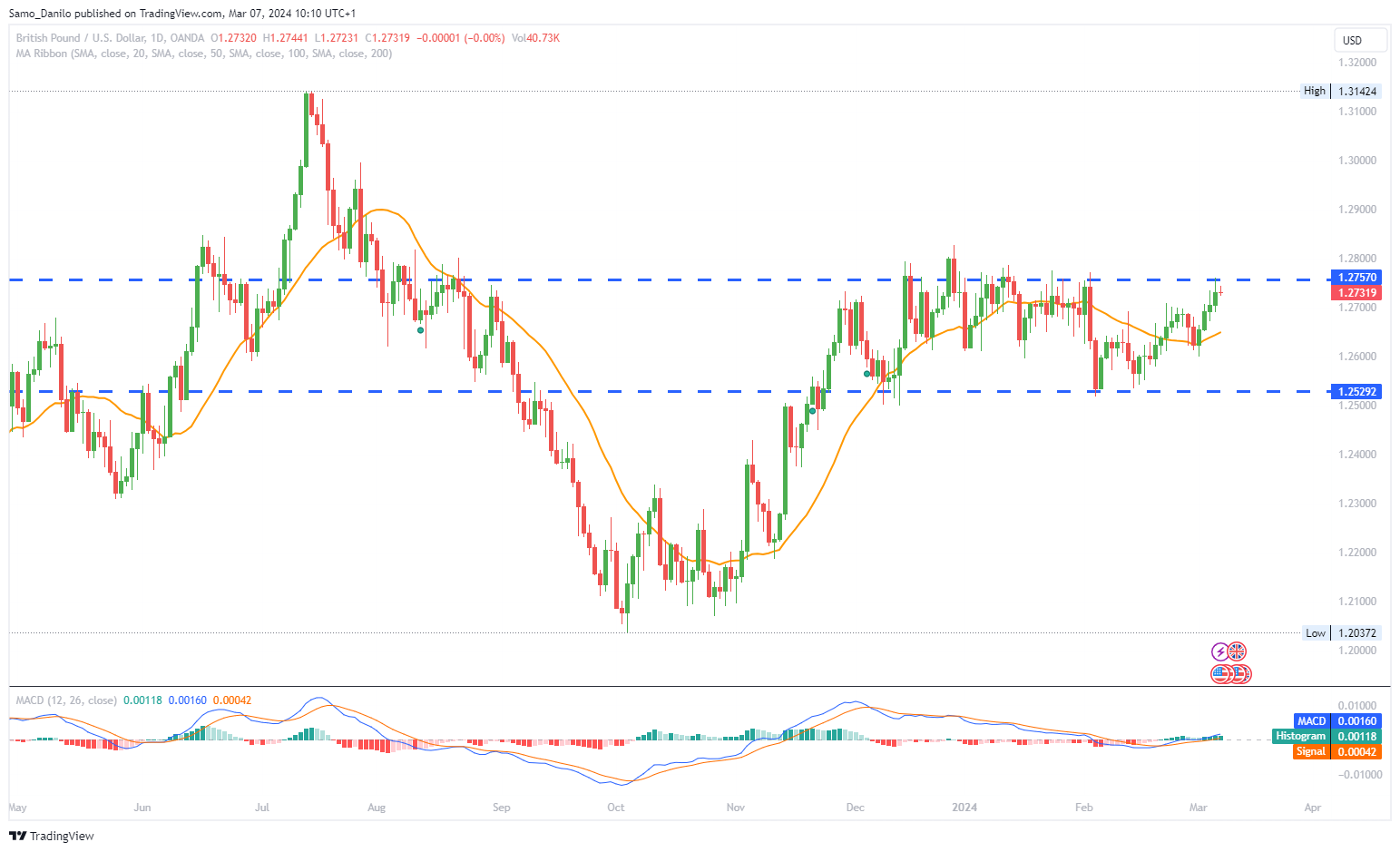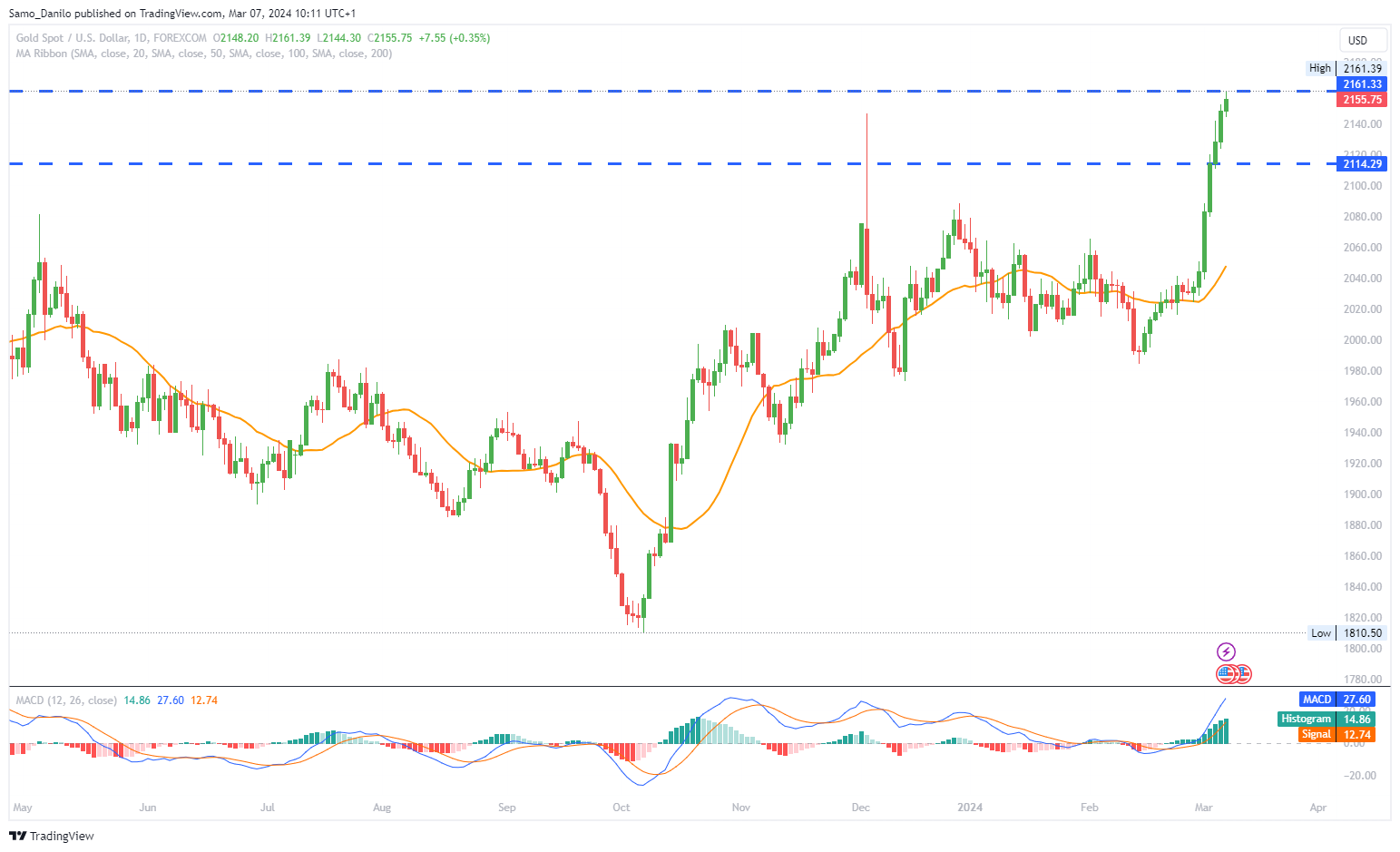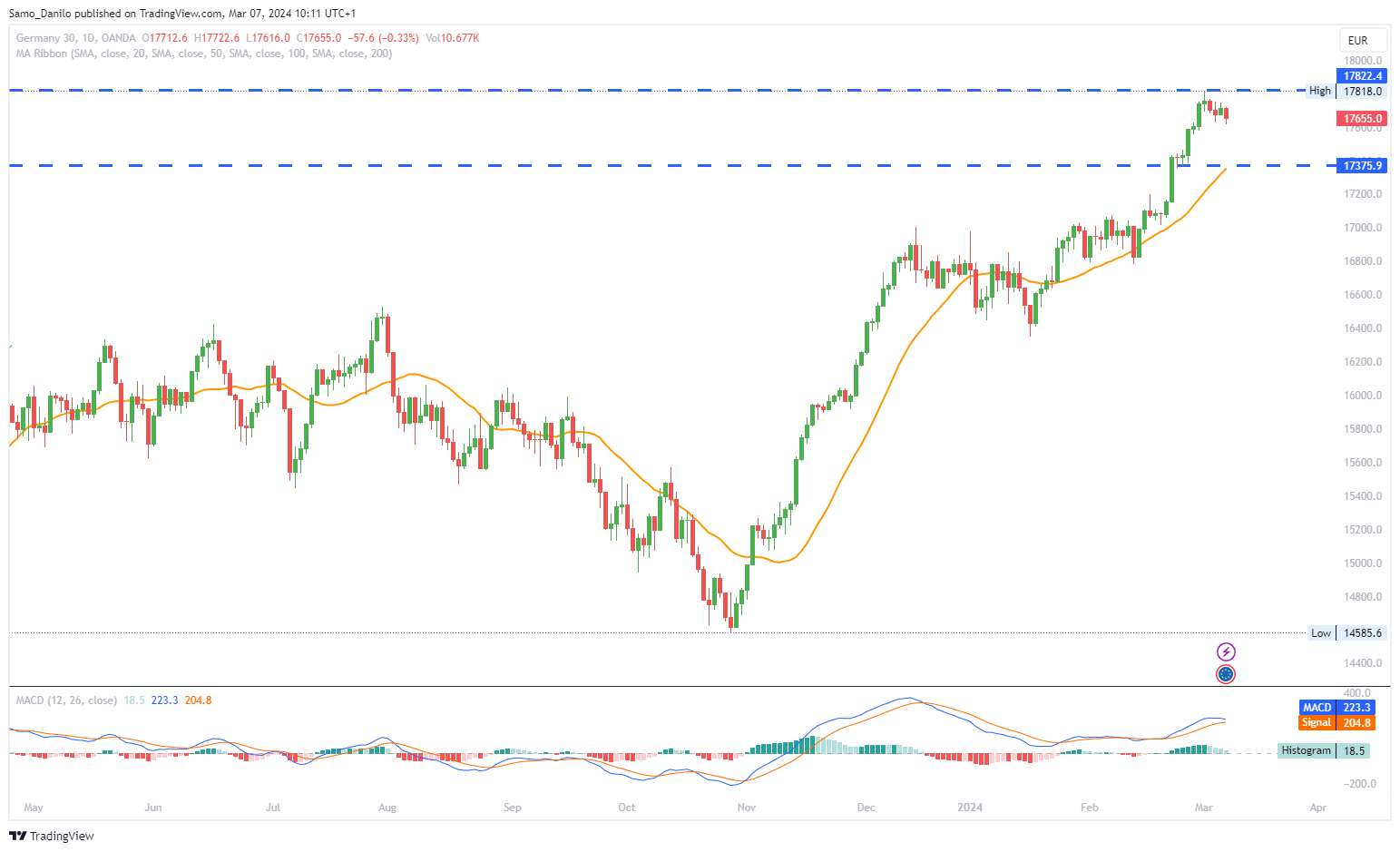EURUSD
- Breakthrough 1.0900 Barrier: The EUR/USD pair successfully breached the critical 1.0900 barrier, reaching multi-week highs. This surge was fueled by increased selling pressure on the US Dollar.
- Weakness in USD Index (DXY): The US Dollar Index (DXY) experienced a decline for the fourth consecutive session, finding itself at five-week lows in the low-103.00s. This persistent weakness in the DXY contributed to the Euro's strength against the Dollar.
- Powell's Statements: Federal Reserve Chair Jerome Powell's comments indicated a likelihood of interest rate reductions within the year. However, Powell emphasized that rate cuts would be implemented only when the Fed gains more confidence in inflation returning to its annual target of 2%.
- ECB's Easing Cycle: The European Central Bank (ECB) is also poised to begin its easing cycle in the coming months. ECB Board member Peter Kazimir expressed a preference for rate reductions in June. This sentiment was supported by softening headline inflation figures in Germany and the broader Eurozone, in contrast to relatively stable core inflation figures.
- Fundamental Contrasts: The euro area's stagnant fundamentals were highlighted in comparison to the robust resilience of the US economy. This scenario supports the notion of a stronger Dollar in the short term, particularly considering the possibility of both the ECB and the Fed initiating their easing programs almost simultaneously.
Closing statement: The EUR/USD pair made notable gains by surpassing the 1.0900 level, driven by a weaker US Dollar. Jerome Powell's remarks on potential rate reductions and the ECB's inclination towards an easing cycle played a significant role in shaping the currency dynamics. The contrast in economic fundamentals between the euro area and the US is a factor contributing to the short-term strength of the Dollar.
GBPUSD
- Breaking 1.2700 Barrier: The GBP/USD pair successfully breached the 1.2700 barrier and is currently trading around 1.2735 during the Asian session on Thursday.
- UK Spring Budget Highlights: Chancellor of the Exchequer Jeremy Hunt presented the spring budget to the House of Commons. According to the Office for Budget Responsibility (OBR), the UK economy is expected to grow by 0.8% in 2024 and 1.9% next year, which is 0.5% higher than the autumn forecast.
- Tax Rate Cut: Hunt announced a tax rate cut in employees' National Insurance from 10% to 8%, along with the freezing of fuel and alcohol duty, as rumored before the announcement.
- Powell's Remarks on US Economy: US Federal Reserve Chair Jerome Powell stated that the US economy is not on the brink of falling into a recession. However, the Fed did not provide clear guidance regarding future interest rate cuts.
- US JOLTS Report: The US Job Openings and Labor Turnover Survey (JOLTS) for January revealed that there were 8.863 million job openings. This figure fell short of expectations and was marginally lower than the previous month's reports of 8.9 million and 8.889 million, respectively.
| SMA (20) | Slightly Rising |
| |
| RSI (14) | Rising |
|
|
| MACD (12, 26, 9) | Slightly Rising |
|
Closing statement: The GBP/USD pair made significant strides by surpassing the 1.2700 level. The UK's spring budget, which included economic growth projections and tax rate cuts, influenced the Pound's performance. Meanwhile, Powell's comments on the US economy and the JOLTS report played a role in shaping the dynamics of the currency pair. The focus remains on how these factors will continue to impact GBP/USD in the coming sessions.
GOLD
- Gold Price Uptrend Continues: Gold price (XAU/USD) is extending its uptrend for the seventh consecutive day on Thursday, reaching a fresh all-time high around the $2,161 area as the market heads into the European session.
- Technical Perspective: From a technical standpoint, the Relative Strength Index (RSI) on the daily chart is signaling extremely overbought conditions. Traders and analysts often watch the RSI for potential reversal signals when an asset is in overbought or oversold territory.
- Powell's Testimony Impact: Federal Reserve (Fed) Chair Jerome Powell, during his semi-annual congressional testimony on Wednesday, reinforced expectations for an imminent interest rate cut later this year. Powell's statements likely influenced the precious metal markets as traders assessed the potential impact on the US dollar and inflation expectations.
- Supporting Factors for Gold: Beyond Powell's testimony, a generally softer tone in the markets, geopolitical tensions from conflicts in the Middle East, and concerns about a slowdown in China are contributing factors that seem to be providing additional support to the safe haven gold price.
- Kashkari's Remarks: Minneapolis Fed President Neel Kashkari downplayed speculations about more aggressive policy easing. This perspective could influence market expectations regarding the pace and extent of future monetary policy measures.
| SMA (20) | Rising |
|
|
| RSI (14) | Rising |
|
|
| MACD (12, 26, 9) | Rising |
|
|
Closing statement: Gold's impressive uptrend is marked by its seventh consecutive day of gains, reaching a new all-time high. Technical indicators, such as the RSI, suggest potential caution due to overbought conditions. Powell's testimony, geopolitical tensions, and concerns about economic slowdowns are currently key drivers. Kashkari's remarks add nuance to the narrative, emphasizing the importance of monitoring central bank communications for further market insights.
CRUDE OIL
- WTI Oil Price Movement: West Texas Intermediate (WTI) oil price is trending lower, hovering near $78.80 per barrel during the Asian trading hours on Thursday.
- Wednesday's Surge: Crude oil prices experienced a surge on Wednesday, driven by data indicating that US oil stockpiles rose less than expected for the week ending on March 1. The US Energy Information Administration (EIA) reported a build in Crude Oil Stocks Change for the sixth consecutive week, amounting to 1.367 million barrels.
- API Weekly Crude Oil Stock Data: The American Petroleum Institute (API) Weekly Crude Oil Stock data also reported a build in stockpiles, registering 0.423 million barrels. This figure contrasts with market expectations of a decrease to 2.6 million barrels, following the previous week's build of 8.428 million barrels.
- USD Influence: Crude oil prices received additional support from a weaker US Dollar (USD) after Federal Reserve (Fed) Chair Jerome Powell indicated during his testimony before the House Financial Services Committee that the central bank is prepared to lower borrowing costs "at some point this year."
- Saudi Arabia's Pricing Decision: The unexpected decision by Saudi Arabia to raise prices of its primary grade for buyers in Asia adds another layer to the market dynamics. This move comes after the Organization of the Petroleum Exporting Countries and its allies (OPEC+) decided to extend voluntary oil output cuts of 2.2 million barrels per day (bpd) into the second quarter.
| SMA (20) | Rising |
|
|
| RSI (14) | Slightly Rising |
| |
| MACD (12, 26, 9) | Rising |
|
|
Closing statement: The Crude oil market is navigating a complex landscape with multiple factors influencing prices. Wednesday's surge was fuelled by lower-than-expected US oil stockpile builds, while the weaker USD provided an additional boost. Saudi Arabia's pricing decision adds a geopolitical element to the mix. Ongoing discussions within OPEC+ and global economic factors will likely continue to shape the trajectory of Crude oil prices in the near term.
DAX
- German Trade Data Impact: On Wednesday, German trade data attracted investor interest. The trade surplus for Germany widened from €22.2 billion to €27.5 billion in January, signaling a positive development in the country's trade balance.
- Limited Impact of Retail Sales Figures: Retail sales figures for the Eurozone had a limited impact on the DAX. Retail sales increased by 0.1% month-on-month in January, following a 0.6% decline in December.
- Factory Orders Decline: Germany's factory orders experienced a significant decline, falling by 11.3% in January. This comes after a substantial surge of 12.0% in December, indicating a notable contraction in demand for manufactured goods.
- Upcoming ECB Monetary Policy Decision: The European Central Bank (ECB) monetary policy decision and press conference are anticipated as the main events. Economists expect the ECB to maintain interest rates at 4.50%. However, lingering uncertainty prevails regarding the timeline for a potential ECB rate cut.
- Focus on ECB Press Conference: The ECB staff's economic and inflation forecasts, along with their views on the timeline for interest rate cuts, will be crucial elements putting the ECB press conference under the spotlight. Any signals or guidance regarding future monetary policy decisions will likely influence investor sentiment.
| SMA (20) | Rising |
|
|
| RSI (14) | Rising |
|
|
| MACD (12, 26, 9) | Rising |
|
|
Closing statement: The DAX is navigating a mixed landscape with positive trade surplus data for Germany but challenges in factory orders. The upcoming ECB monetary policy decision and press conference will be critical in determining the short-term direction of the DAX. Investor attention will be on any indications or insights provided by the ECB regarding economic conditions and potential adjustments to interest rates.




